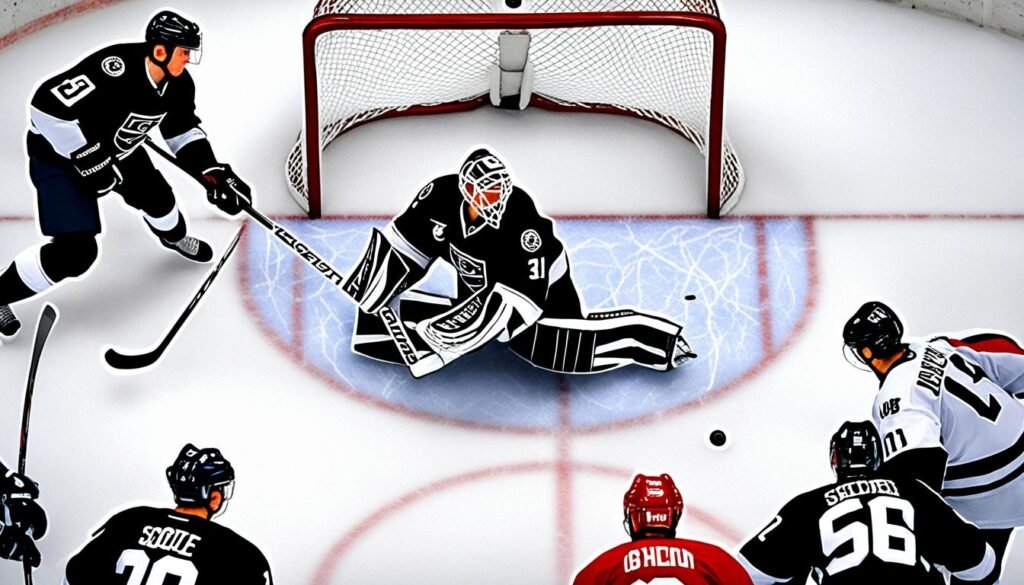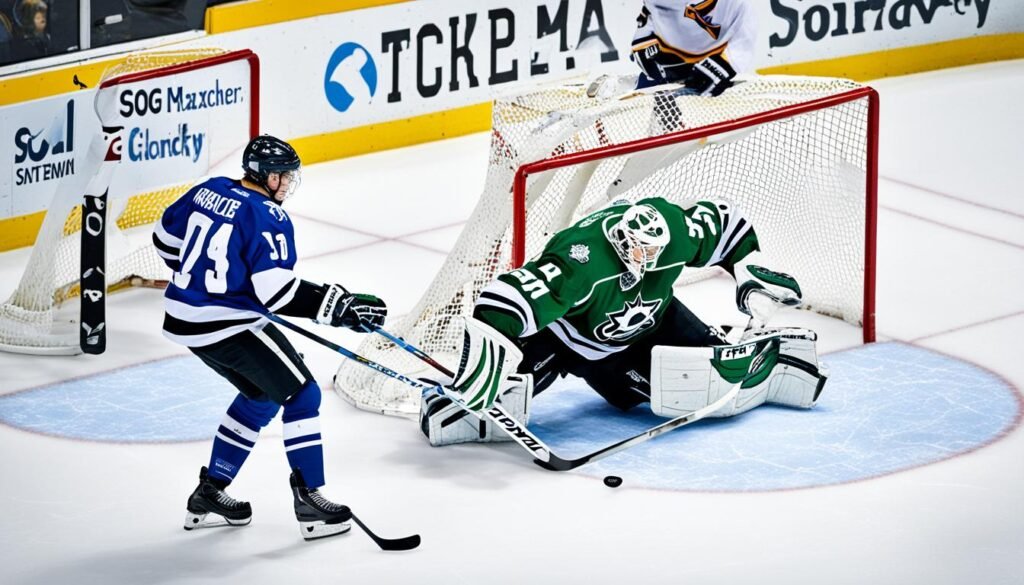Welcome to our comprehensive guide to hockey statistics! In this article, I will decode one commonly used stat, SOG. What does SOG mean in hockey? It stands for Shots on Goal. Understanding this statistic is crucial for hockey fans and enthusiasts looking to gain deeper insights into the game.
SOG refers to the number of shots a player takes, a team takes, or the number of shots a goalie faces during a game. It provides valuable information about a player’s offensive performance, a team’s shooting ability, and a goalie’s save opportunities.
A shot on goal is registered if the goalie is required to stop the puck, which otherwise would have resulted in a goal. This means that shots that hit the post or miss the net, unless the goalie makes a save, are not counted as shots on goal.
Key Takeaways:
- SOG stands for Shots on Goal in hockey.
- It tracks the number of shots a player takes, a team takes, or the number of shots a goalie faces.
- Shots on goal do not include shots that hit the post or miss the net without the goalie making a save.
- High SOG indicates an active offensive presence, while high shots faced by a goalie showcase their ability to make saves under pressure.
- Additional statistics, such as shooting percentage, should be considered to fully understand a player’s or team’s performance.
Importance of SOG in Hockey
Shots on goal (SOG) play a critical role in evaluating a player’s offensive performance and a goalie’s ability to make saves. An impressive number of SOG indicates an active offensive presence, reflecting a player’s consistency in generating shooting opportunities, and increasing their chances of scoring goals. On the other hand, when a goalie faces a high number of shots, it demonstrates their capability to make saves under pressure, highlighting their importance in protecting the net.
Rosters, coaching staff, and analysts study SOG statistics to assess players’ effectiveness on the ice and make tactical decisions during games. The number of SOG can influence defensive and offensive strategies as teams adapt their approach based on the quantity of shots on goal. It’s a dynamic statistic that can shape the flow of a game and impact the final outcome.
Take a look at the following table to see how different teams in the National Hockey League (NHL) compare in terms of SOG:
| Team | Games Played | Total SOG |
|---|---|---|
| New York Rangers | 82 | 2,815 |
| Tampa Bay Lightning | 82 | 2,789 |
| Colorado Avalanche | 82 | 2,765 |
| Boston Bruins | 82 | 2,731 |
| Washington Capitals | 82 | 2,706 |
As seen in the table, different teams showcase varying levels of offensive aggression, highlighting their strengths and playing styles. Analyzing SOG statistics helps in determining a team’s offensive prowess and provides insights into their performance throughout the season.
Shots on goal are not only a numerical measurement, but they also reflect the intensity and skill of players on the ice. A player or team consistently generating a high number of SOG demonstrates their proactive approach and ability to create scoring opportunities. By closely monitoring SOG, players and teams can identify areas for improvement and adjust their strategies to optimize offensive output.
Interpreting SOG Statistics
When analyzing shots on goal (SOG) statistics in hockey, it’s essential to consider the context and compare them to other players or teams. A high number of SOG doesn’t necessarily indicate a successful player or team if the shooting accuracy is low. To fully interpret a player’s or team’s performance, additional statistics such as shooting percentage should be taken into account.
For example, a player with a high number of SOG but a low shooting percentage may need to improve their accuracy. On the other hand, a player with a lower number of SOG but a high shooting percentage may be more efficient in scoring goals. Therefore, it’s crucial to analyze SOG in combination with shooting percentage to gain a comprehensive understanding of a player or team’s offensive capabilities.
An effective way to present SOG statistics in relation to shooting percentage is through a table:
| Player | SOG | Shooting Percentage |
|---|---|---|
| Alex Ovechkin | 250 | 15% |
| Connor McDavid | 200 | 20% |
| Steven Stamkos | 180 | 25% |
In the table above, we can observe the number of SOG for three different players along with their shooting percentages. Although Alex Ovechkin has the highest number of SOG, his shooting percentage is lower compared to Connor McDavid and Steven Stamkos. This indicates that McDavid and Stamkos are more efficient in converting their shots into goals.
By interpreting SOG statistics in conjunction with shooting percentage, coaches and scouts can identify areas for improvement and tailor strategies to maximize a player’s or team’s offensive output.


What Constitutes a Shot on Goal
A shot on goal is an essential statistic in hockey that measures the number of shots that could potentially result in a goal. Understanding what constitutes a shot on goal is crucial for accurate data analysis and performance evaluation.
Here are the key criteria for a shot to be considered a shot on goal:
- The shot would have resulted in a goal if the goalie had not made a save.
- The shot directly results in a goal.
On the other hand, the following scenarios are not counted as shots on goal:
- Shots that hit the post or miss the net, unless the goalie makes a save.
- Blocked shots that are deflected by an opponent.
- Shots that go wide or high and miss the net.
- Own goals scored by a team on its own net.
Shots on goal can come from various shot types, including tip-ins, redirects, penalty shots, and overtime goals. These shots are taken with the intention of scoring and are counted in the shots on goal statistics.
Now let’s take a closer look at the distribution of different shot types in the NHL:
| Shot Type | Percentage |
|---|---|
| Wrist Shot | 62% |
| Slap Shot | 22% |
| Backhand | 5% |
| Tipped Shot | 4% |
| Snap Shot | 3% |
| Deflected Shot | 2% |
| Wrap-around | 2% |
This table illustrates the different shot types used by players in the NHL, with wrist shots being the most common type. The distribution provides valuable insights into the shooting strategies employed by players and teams.
By understanding what constitutes a shot on goal and analyzing the distribution of shot types, coaches, players, and analysts can gain a deeper understanding of offensive strategies, shooting accuracy, and overall team performance.
Other Hockey Statistics
In addition to shots on goal, there are several other statistics commonly tracked in ice hockey. These statistics provide a comprehensive view of a team’s and player’s performance and can be used to analyze and compare different players and teams. Let’s take a closer look at some of the key hockey stats:
Team Statistics
- Goals For
- Goals Against
- Wins
- Losses
- Ties
- Points
Individual Statistics
- Goals
- Assists
- Points
- Penalty Minutes
- Power Play Goals
- Shorthanded Goals
- Game-Winning Goals
Goaltender Statistics
- Goals Against
- Saves
- Save Percentage
- Shutouts
These statistics provide valuable insights into a team’s offensive and defensive performance, as well as an individual player’s contributions. Analyzing these stats alongside shots on goal can help in identifying areas of strength and weaknesses in team performance and evaluating individual players’ effectiveness on and off the ice.


Analyzing SOG in Relation to Other Statistics
Analyzing shots on goal in relation to other statistics can provide valuable insights into a player’s or team’s overall performance in hockey. By examining the relationship between shots on goal and various other metrics, we can gain a better understanding of shooting accuracy, offensive efficiency, defensive strengths, and weaknesses.
One key aspect to consider when analyzing shots on goal is the number of goals scored. By comparing the number of shots on goal to the number of goals, we can assess a player’s shooting accuracy. A high number of shots on goal with a low shooting percentage may indicate that the player needs to improve their finishing skills. On the other hand, a high shooting percentage suggests a player’s ability to convert a significant portion of their opportunities into goals.
Furthermore, analyzing shots on goal in combination with other offensive and defensive statistics can reveal valuable insights into a team’s performance. Whether it’s comparing shots on goal to goals allowed, power play conversion rates, or penalty kill effectiveness, these analyses help identify areas of strength and weakness in a team’s strategy. For example, a team with a high number of shots on goal but a low scoring percentage could indicate a need to work on offensive efficiency and shot quality.
Let’s take a closer look at how shots on goal can be analyzed in relation to other statistics:
1. Shooting Percentage
Shooting percentage is a crucial metric that measures the effectiveness of a player or team in converting shots on goal into goals. It is calculated by dividing the number of goals scored by the number of shots on goal and multiplying by 100. Comparing the shooting percentages of different players or teams can provide insights into their efficiency and scoring ability.
2. Power Play Performance
The power play is a critical phase of the game where a team has a numerical advantage due to an opponent’s penalty. Analyzing a team’s shots on goal during power play opportunities can help evaluate their offensive effectiveness in these situations. A high number of shots on goal during power plays indicates a team’s ability to create scoring opportunities and generate offensive pressure.
3. Penalty Kill Efficiency
The penalty kill is another important aspect of the game, where a team tries to successfully defend against an opponent’s power play. Analyzing a team’s ability to limit shots on goal while short-handed can provide insights into their defensive strength. A low number of shots on goal against during penalty kills suggests effective defensive positioning and shot-blocking skills.
Conclusion
Shots on goal (SOG) is a crucial statistic in hockey that provides valuable insights into player and team performance. By tracking the number of shots taken by players, teams, or the shots faced by goalies, SOG offers a comprehensive view of offensive capabilities, defensive strengths, and a goalie’s ability to make saves.
Interpreting shots on goal statistics requires careful analysis and comparison with other metrics, such as shooting percentage. A high number of shots on goal doesn’t always translate to success if the shooting accuracy is low. By considering additional factors, teams and players can determine areas of improvement and develop effective strategies.
While shots on goal is an essential stat, it is just one piece of the larger hockey statistics puzzle. Various other metrics, including goals, assists, penalty minutes, and save percentage, contribute to a comprehensive understanding of team and player performance. By analyzing shots on goal in relation to these statistics, teams and players can identify strengths, weaknesses, and implement strategies for continual improvement.
In summary, shots on goal is a fundamental statistic in hockey that plays a vital role in evaluating player and team performance. With careful analysis and consideration of other statistics, teams and players can gain valuable insights and make data-driven decisions to enhance their game.

